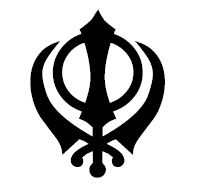Khanda & Khanda insignia
KHANDA & KHANDA INSIGNIA
Khanda is a double-edged sword. The word has its root in Khand (literally: to cut); hence a weapon which cuts (the body of the enemy).
Khanda is a very powerful weapon. It was a common weapon of battlefield up to the nineteenth century. The relics of Guru Sahib as well as some Sikh generals preserved at Akaal Takht Bunga (Darbar Sahib Amritsar) include a few Khandas, which are very heavy in weight.
Pahul (nectar for initiation of a Sikh which is wrongly called Amrit) is prepared with a Khanda (which was, earlier, more oblong in the middle, as compared to the Khandas with which Pahul is given nowadays). The first ceremony of Khande Di Pahul (the Sikh initiation) took place, at Anandpur Sahib, by Guru Gobind Singh. The Khanda, with which Pahul was prepared on the first day, has been preserved at Kesgarh Sahib, Anandpur Sahib.
KHANDA (the Sikh insignia)

Khanda is an emblem of the Sikhs. It consists of two Kirpaans (the Sikh swords) on both sides, one Khanda (double-edged sword) in the centre and one Chakkar (quoit) around the Khanda (double-edged sword).
Khanda emblem was not carved or designed by Guru Gobind Singh. The British first used it during the second half of the nineteenth century, for the turbans of the soldiers of the Sikh Regiment, to give them a distinct identity.
The earlier insignia designed by the British had only one Chakkar (quoit) and a small Khanda (double-edged sword) around it.
Two more swords were added to this insignia by the Sikhs during the Singh Sabha movement (1873 to 1900). With the passage of time, various Sikh organisations adopted it as national insignia.
Different scholars have given different interpretations for the three articles of the insignia. One view is that the two swords represent spiritual and temporal sovereignty of the Sikh nation, Chakkar (quoit) symbolizes the circular design of the universe; and Khanda (double-edged sword) symbolizes initiation. Thus, sovereignty, infinity and initiation are three basic points of the Sikh national emblem. But, this is just personal view of that person who has defined it so. The truth is that it is just a symbol. It has its root in Sikh hisotry and has nothing to do with philosophy.
(Dr Harjinder Singh Dilgeer)